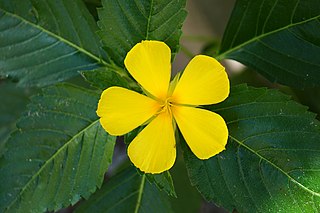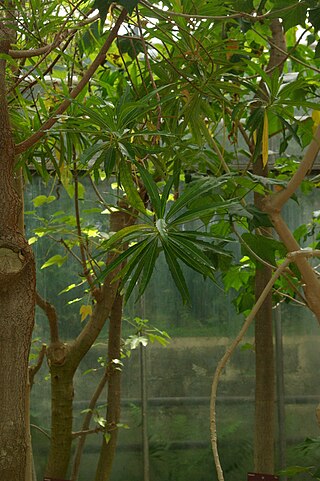
The Malpighiales comprise one of the largest orders of flowering plants, containing about 36 families and more than 16,000 species, about 7.8% of the eudicots. The order is very diverse, containing plants as different as the willow, violet, poinsettia, manchineel, rafflesia and coca plant, and are hard to recognize except with molecular phylogenetic evidence. It is not part of any of the classification systems based only on plant morphology. Molecular clock calculations estimate the origin of stem group Malpighiales at around 100 million years ago (Mya) and the origin of crown group Malpighiales at about 90 Mya.

Aerides, known commonly as cat's-tail orchids and fox brush orchids, is a genus belonging to the orchid family. It is a group of tropical epiphyte orchids that grow mainly in the warm lowlands of tropical Asia from India to southern China to New Guinea. They are valued in horticulture for their racemes of showy, fragrant, colorful flowers.

Hibiscus rosa-sinensis, known colloquially as Chinese hibiscus, China rose, Hawaiian hibiscus, rose mallow and shoeblack plant, is a species of tropical hibiscus, a flowering plant in the Hibisceae tribe of the family Malvaceae. It is widely cultivated as an ornamental plant in the tropics and subtropics, but its native range is Vanuatu.

Cymbidium, commonly known as boat orchids, is a genus of evergreen flowering plants in the orchid family Orchidaceae. Orchids in this genus are epiphytic, lithophytic, terrestrial or rarely leafless saprophytic herbs usually with pseudobulbs. There are usually between three and twelve leaves arranged in two ranks on each pseudobulb or shoot and lasting for several years. From one to a large number of flowers are arranged on an unbranched flowering stem arising from the base of the pseudobulb. The sepals and petals are all free from and similar to each other. The labellum is significantly different from the other petals and the sepals and has three lobes. There are about fifty-five species and sixteen further natural hybrids occurring in the wild from tropical and subtropical Asia to Australia. Cymbidiums are well known in horticulture and many cultivars have been developed.

The Passifloraceae are a family of flowering plants, containing about 750 species classified in around 27 genera.

Echinops is a genus of about 120 species of flowering plants in the family Asteraceae, commonly known as globe thistles. They have spiny foliage and produce blue or white spherical flower heads. They are native to Europe, east to central Asia, and south to the mountains of tropical Africa. Globe thistle is the host plant of weevil Larinus vulpes.

Sobralia is a genus of orchids native to Mexico, Central and South America. The plants are more commonly terrestrial, but are also found growing epiphytically, in wet forests from sea level to about 8,800 ft. The genus was named for Dr. Francisco Sobral, a Spanish botanist. The genus is abbreviated Sob in trade journals.

Turneraceae Kunth ex DC. is a family of flowering plants consisting of 120 species in 10 genera. The Cronquist system placed the Turneracids in the order Violales, but it is not currently recognized as a family by the Angiosperm Phylogeny Group in the APG III system of 2009, which includes the taxa in the Turneraceae in Passifloraceae as a subfamily (Turneroideae).

The greater hedgehog tenrec, also known as the large Madagascar hedgehog or sokina, is a species of mammal in the family Tenrecidae. It is endemic to Madagascar. Its natural habitats are subtropical or tropical forests, shrubland and grassland, savanna, rural gardens, and urban areas.

Turnera is a genus of flowering plants in the passionflower family, Passifloraceae. It contains more than 100 species native to tropical and subtropical America. The name honours English naturalist William Turner (1508–1568). It was previously placed in the family Turneraceae.

Robert Allen Rolfe was an English botanist specialising in the study of orchids. For a time he worked in the gardens at Welbeck Abbey. He entered Kew in 1879 and became second assistant.

Bursera fagaroides is a species of flowering plant in the genus Bursera known by the common names torchwood copal and fragrant bursera. It is widespread across much of Mexico from Sonora to Oaxaca, and its range extends just into Arizona in the United States, although some sources suggest that it may now be extirpated in Arizona.

Turnera subulata is a species of flowering plant in the passionflower family known by the common names white buttercup, sulphur alder, politician's flower, dark-eyed turnera, and white alder. Despite its names, it is not related to the buttercups or the alders. It is native to Central and South America, from Panama south to Brazil. It is well known in many other places as an introduced species, such as Malaysia, Indonesia, several other Pacific Islands, the Caribbean, and Florida in the United States.

Adenoa is a monotypic genus of flowering plants belonging to Turneroideae (Passifloraceae).

Afroqueta is a genus of flowering plants belonging to Turneroideae (Passifloraceae). It is a monotypic group, consisting of Afroqueta capensis(Harv.) Thulin & Razafim.

Mathurina is a monotypic genus of flowering plants belonging to the family Passifloraceae. The only species is Mathurina penduliflora.

Loewia glutinosa is a species of shrub from East Kenya belonging to the family Passifloraceae., Ethopia, and Somalia.

Oxossia is a genus of flowering plants in the subfamily Turneroideae (Passifloraceae) consisting of 15 species. This genus was recently defined in 2019 after a phylogenetic analysis of Turnera justified the creation of the genus. The genus is characterized by its stipules, small flowers, congested inflorescences, "hairy" stamen and style, and the attachment of stamen to the floral tube. All members of the genus are heterostylous with the exception of O. dasystyla. The genus can be divided into two morphological groups: those with white petals and those with yellow pink or red petals.
Stapfiella zambesiensis is a shrub native to Zambia, Africa. It is found east of Kasama.
Oxossia hatschbachii is a species of shrub in the genus Oxossia (Passifloraceae). It is native to the Atlantic Rainforest near Espírito Santo, Brazil. O. hatchbachii has heterostylous racemose flowers, ranging in color from white to red.


















